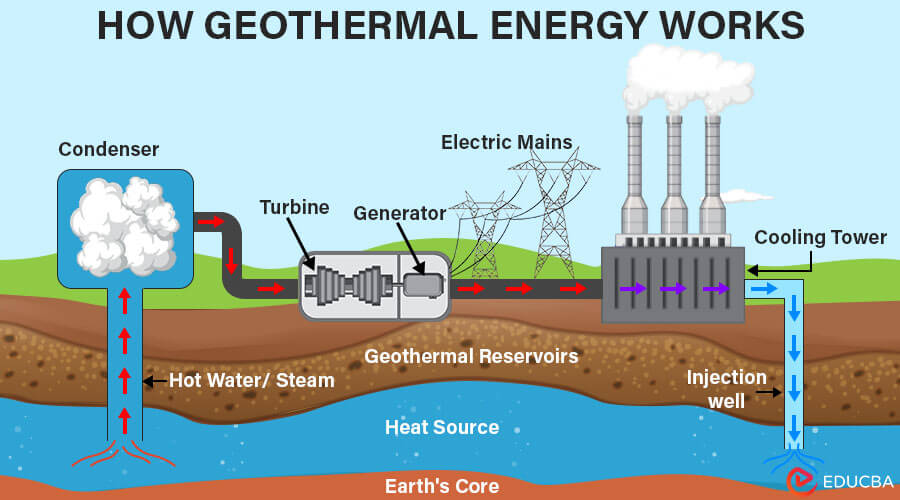In a world increasingly driven by the demand for clean and renewable energy, geothermal energy stands out as a powerful and reliable solution. But how geothermal energy works is a question many beginners still have. This guide will simplify the science, explore its applications, and show why geothermal power is more relevant today than ever before.
What Is Geothermal Energy?
A Natural Heat Source Beneath Our Feet
Geothermal energy is the heat that comes from the Earth’s core. This internal heat is produced by the slow decay of radioactive particles in the Earth’s crust and mantle. It’s available 24/7, regardless of weather conditions, making it one of the most reliable renewable energy sources.
Sources of Geothermal Energy:
- Hot water reservoirs deep underground
- Hot dry rocks heated by the Earth’s core
- Natural geysers and hot springs
How Geothermal Energy Works
The key to understanding how geothermal energy works lies in the way we capture and use underground heat to generate electricity or heat buildings. There are two main systems: geothermal power plants and direct-use heating systems.
1. Geothermal Power Plants (For Electricity)
These facilities use heat from the Earth to produce steam, which drives turbines connected to generators.
Main Types of Geothermal Power Plants:
- Dry Steam Plants: Use natural steam directly from underground to turn turbines.
- Flash Steam Plants: Pump high-pressure hot water to the surface; when pressure drops, it flashes into steam to power turbines.
- Binary Cycle Plants: Use moderate-temperature water to heat a secondary fluid with a lower boiling point, which vaporizes and drives a turbine.
2. Geothermal Heating and Cooling (Direct Use)
This method doesn’t generate electricity but instead uses geothermal heat directly to warm buildings, greenhouses, or water. It’s highly efficient and popular in regions with abundant geothermal resources.
Common Direct-Use Applications:
- District heating systems
- Hot spring spas and pools
- Industrial drying processes
Geothermal Heat Pumps: An Everyday Solution
Geothermal heat pumps (GHPs), also called ground-source heat pumps, are popular in residential and commercial buildings. They don’t rely on deep geothermal resources but instead use the relatively stable temperature a few feet underground to regulate indoor climates.
How They Work:
- A loop system buried underground circulates water or refrigerant.
- In winter, the fluid absorbs heat from the ground and brings it indoors.
- In summer, the system works in reverse, transferring heat from the building back into the earth.
Benefits of Geothermal Energy
Geothermal energy offers several advantages that make it attractive for governments, utilities, and homeowners alike.
Top Benefits:
- Renewable: It’s naturally replenished and essentially limitless.
- Low Emissions: Produces minimal greenhouse gases.
- Reliable: Not dependent on weather or sunlight.
- Small Land Footprint: Requires less surface area than solar or wind farms.
- Low Operating Costs: Once installed, systems are cost-effective and long-lasting.
Challenges of Geothermal Energy
Like any energy source, geothermal has its limitations, especially related to location and cost.
Main Challenges:
- Location Specific: Best suited for regions with geothermal activity (e.g., Iceland, parts of the U.S., New Zealand).
- High Initial Costs: Drilling and plant construction are expensive upfront.
- Risk of Depletion: If not managed well, reservoirs can cool over time.
- Environmental Concerns: Potential for land subsidence and release of trace gases during drilling.
Where Is Geothermal Energy Used?
Geothermal energy is most prominent in geologically active regions. Countries leading the way include:
- Iceland: Nearly 90% of homes use geothermal heating.
- United States: Especially in states like California, Nevada, and Utah.
- Philippines and Indonesia: Rich in volcanic activity and home to large geothermal plants.
The Future of Geothermal Energy
Technological advances are making geothermal more accessible, even in areas without traditional volcanic activity. Innovations include:
- Enhanced Geothermal Systems (EGS): Use artificial stimulation to create reservoirs in hot dry rock.
- Deeper Drilling Technologies: Allow access to higher-temperature zones.
- Hybrid Plants: Combine geothermal with solar or other renewables for improved efficiency.
As nations seek sustainable and reliable energy solutions, geothermal’s role is set to expand significantly.
In conclusion, understanding how geothermal energy works gives us insight into one of the most dependable and eco-friendly power sources available. By tapping into the Earth’s natural heat, we can reduce our reliance on fossil fuels and move toward a more sustainable future. Whether through large-scale power plants or home heat pumps, geothermal technology offers real solutions for real-world energy needs.




Pingback: Is Geothermal Energy Really Sustainable? -